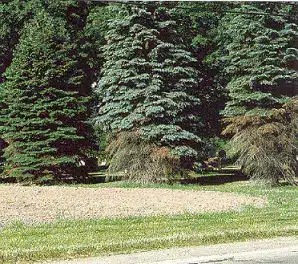Ah, it’s the age-old tree mystery. Your tree is looking under the weather, the leaves are sparse (at a time when they shouldn’t be) and it seems to be crying out for help. What could it be?
Well, there are a number of possible scenarios, but your maple might be suffering from a classic case of girdling roots. Imagine putting on a belt and pulling it tighter and tighter until you can’t breathe. That’s what girdling roots do to your tree: strangle it.
Girdling roots occur when the tree’s roots wrap around the trunk instead of spreading out. These rebellious roots can squeeze the tree, cutting off its essential nutrient and water supply. It’s like the tree version of wearing skinny jeans that are just too tight. Trees need to breathe, too.
But how does a tree put on skinny jeans in the first place? Guess what? If it doesn’t sound natural, it isn’t. Trees can develop girdling roots due to several human-induced factors:
- Planting too deep: Trees are like Goldilocks when it comes to planting depth—get it just right, or face the consequences.
- Container-grown roots: Trees grown in pots can develop circular root patterns. When transplanted, these roots continue their merry-go-round right into girdling.
- Poor soil conditions: Compacted soil can force roots to grow in all the wrong directions.
So how do you know if your tree has girdling roots? The most obvious sign is that you might be able to literally see them circling the trunk. But trees usually don’t make things so obvious when more nefarious things are going on under cover.
The next best (or worse?) sign is sparse foliage and underdeveloped leaves. When a trees’ trunk is constricted, it just can’t get the nutrients it needs from the farthest parts of the tree, which suffer first. You might also notice that they start to lose their autumn leaves a little too early.
Thankfully, girdling roots are not always a terminal prognosis and your tree can be saved. To do so, you’ll need to channel your inner detective and inspect the root zone. If you find girdling roots, here are a few steps you can take:
Careful excavation: Gently remove the soil around the base of the tree to expose the roots but be careful not to damage the good ones. Depending on the size of the tree and soil conditions this can be quite difficult. If it becomes too challenging, our team has a very fancy-pants tool called an Airspade that jets high pressure air into the soil without damaging roots.
Root surgery: With a clean, sharp tool, carefully cut away the girdling roots. It’s like untangling a knot in your daughter’s necklace—patience is key. Typically, we gently use hand pruners but for the more stubborn ones, we employ a hammer and chisel.
The best method, however, is prevention. When planting new trees, don’t plant them too deep. You should always be able to see the exposed root flare of the tree above the soil.
And for the love of trees, please don’t cover the trunk with a “mulch volcano.” Your tree with thank you. Also, when planting container trees, always tease out the roots to give them a good start.
Remember, trees have a lot to deal with—pests, diseases, and now fashion faux pas like girdling roots. Give them some love and attention, and they’ll repay you with shade and beauty for years to come.





